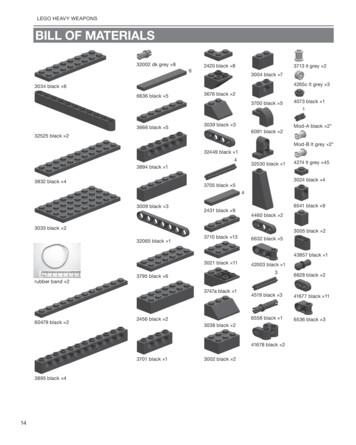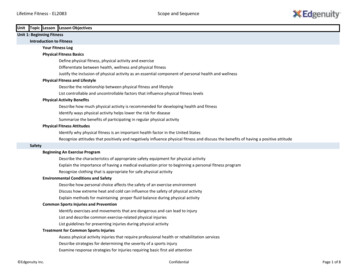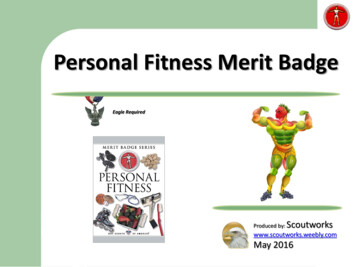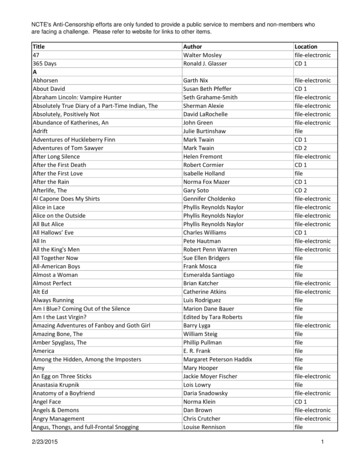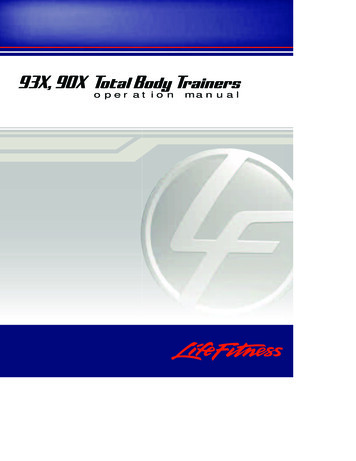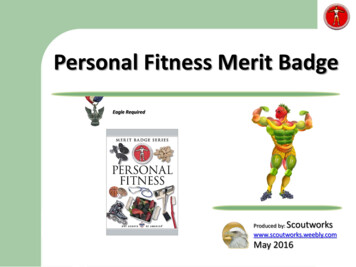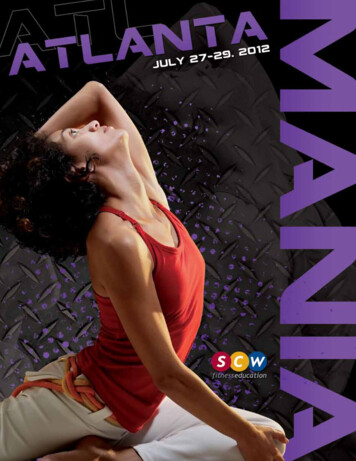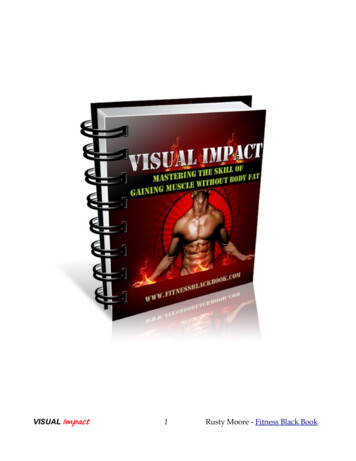
Transcription
VISUAL Impact1Rusty Moore - Fitness Black Book
Copyright NoticeNo part of this report may be reproduced or transmitted in anyform whatsoever, electronic, or mechanical, including photocopying,recording, or by any informational storage or retrieval system withoutexpressed written, dated and signed permission from the author. Allcopyrights are reserved.Disclaimer and/or Legal NoticesThe information provided in this book is for educational purposes only.I am not a doctor and this is not meant to be taken as medical advice.The information provided in this book is based upon my experiencesas well as my interpretations of the current research available.The advice and tips given in this course are meant for healthy adultsonly. You should consult your physician to insure the tips given in thiscourse are appropriate for your individual circumstances.If you have any health issues or pre-existing conditions, pleaseconsult with your physician before implementing any of the informationprovided in this course.This product is for informational purposes only and the author doesnot accept any responsibilities for any liabilities or damages, real orperceived, resulting from the use of this information.VISUAL Impact2Rusty Moore - Fitness Black Book
Table of ContentsIntroduction: The Meat-Head Movement is Strong!Why training to look and feel better has better isfrowned upon by “real” lifters.5Chapter 01: Concentrating on “The Big 3”?Building a body based on the dead-lift, squat,and bench press creates imbalances for most.8Chapter 02: The 2 Main Types of Muscle GrowthSarcoplasmic Hypertrophy VsMyofibrillar Hypertrophy13Chapter 03: “Cumulative Fatigue"Building fatigue in the muscle from set-to-setto increase muscle mass quickly.17Chapter 04: A High Volume of Sets and RepsA high volume of sets and reps is idealwhen building muscle is the main goal.19Chapter 05: Hybrid Muscle BuildingMixing different muscle building and strengthtraining principles for your ideal results.20Chapter 06: How Much Muscle Can You Gain?The answer to this question is largely determinedby how much muscle you have already gained.22Chapter 07: Eating for Muscle GainsYou want to eat just a little over maintenance whilegetting enough protein and without becoming obsessed.24VISUAL Impact3Rusty Moore - Fitness Black Book
Chapter 08: Only Proven Muscle Building SupplementThere is only one muscle building supplementworth taking. Everything else is unnecessary.29Chapter 09: Setting Up Your Workout RoutineDiscussing the need to customize routinesto make them ideal for you and your goals.31Chapter 10: Phase I - Sarcoplasmic HypertrophyRapid muscle growth by using the principles ofhigh volume and high fatigue.33Chapter 11: Phase II – Increase Muscle and DensityA combination of increasing strength, muscle densityand muscle size simultaneously.41Chapter 12: Phase III – Max Density and DefinitionHardening up the muscles to the max whiledropping excess body fat.48Chapter 13: Bonus Phase – Shrink Wrap Your MusclesReplicating the method that Taylor Lautner and othershave “accidentally” used to look ultra sharp.57Chapter 14: Building Mass on Upper Body OnlyJust focusing on building size in the upper bodyor specializing on a particular body part.61Chapter 15: Final Thoughts64VISUAL Impact4Rusty Moore - Fitness Black Book
Introduction The Meat-Head MovementOkay, time to rant a bit.There was a time not too long ago, when it was okay to train to improve thelook of your physique. It was fine to not only focus on strength andfunctional fitness, but it was cool to actually care about the appearance ofyour body as well.A nice looking body? What a Novel concept!These days it is almost like a bragging right to have the bulky look with littlemuscle definition. Guys at “muscle building” sites care more about rawnumbers rather than appearance. Total body weight & how much someonecan lift in one of the BIG exercises is what many guys focus on these days.Go to any hardcore weight lifting forum.The guys who command a lot of respect are, more times than not, the oneswho have a build like a professional wrestler. You know the type.the guyswho wear skull caps and brag about training in “hardcore dungeon” typegyms. Even many of the fitness experts on these massive sites have nothingclose to an aesthetic physique.but many of them are strong.I believe a fit & muscular guy should have at least some ab definition.If you don't have at least a little ab definition, then I won't take fitness advicefrom you.end-of-story. Gaining muscle and gaining fat at the same time iseasy as hell. Strength will come along with the increased leverage that the fatprovides, but that is NOT impressive.at all.VISUAL Impact5Rusty Moore - Fitness Black Book
The “Go Big or Go Home” SyndromeIt is too bad that much of the sites dedicated to building muscle have thisstrange aura about them. Many of you reading this will know exactly what Iam talking about. It is like they are detached from the outside world. Astrange community that feels like it is run by an army of bulky bald guys withgoatees (not putting that look down, but it does have an unusually largeamount of guys who sport that look).Appearance and style is only for pansies in “Muscle Building Land”You would have to be a wussy to care about style and appearance, right?“Real men” don't care about these things.at least this is what is spoken of inmuscle building circles. In these same circles, guys like Brad Pitt, DanielCraig, Cam Gigandet, Taylor Lautner, and Ryan Reynolds.aren't inimpressive shape, because they can't bench 300 pounds or squat 405 poundsfor reps.The Irony in all of this!Outside of this strange muscle building community, things are 100% theopposite. Men would rather look like Daniel Craig or Ryan Reynolds thanbench press 350 pounds. Younger guys want a physique like Cam Gigandetand Taylor Lautner and could care less if their squat totals is over 400pounds.I pulled out of Meat-Head world many years agoI never really became a true meat-head, but I did get caught up in some ofthis madness about 20 years ago. My goal was to gain as much muscle asgenetically possible.and I went from 175 up to 225 pounds in a little overtwo years. After slimming down, I cut down to 215 pounds.I gained 40 pounds of muscle in a little over 2 years and looked terrible!To be honest, the first 25 pounds were gained within 6 months. I should havestopped there. The remaining 15 pounds were added to my hips, butt andVISUAL Impact6Rusty Moore - Fitness Black Book
thighs as I worked my squat from sets of 6 with 225 pounds, up to sets of 6with 405 pounds.I received a lot of compliments in the gym on leg day back then.A lot of guys claim to squat with 4 plates per side (or more), but I rarely seethis done on a regular basis. I'm 6'3” with some seriously long legs. When Iwas squatting 405 for sets of 6 rock-bottom reps.people would stop whatthey were doing and would watch. The bar had to travel a long distance.Unfortunately that leg, hip and butt mass didn't create a great look.I had a hard time fitting into jeans or dress pants. I was also more sluggish.Squatting strength doesn't necessarily translate into athleticism. If I could goback in time, I would have squatted for possibly the first 3-6 months to buildup a little base muscle and then would have never done that lift again.My Advice?Squats and dead lifts are extremely effective at building mass, but youprobably only need to do them for a few months when you first begin lifting.Even then, you should be careful. Yes.they will put on muscle mass.butoften times in the hips, butt, upper thighs. You really don't want a lot ofexcess mass in these areas if you are looking for a pleasing physique.This leads us to the next chapter.VISUAL Impact7Rusty Moore - Fitness Black Book
Chapter 1“The Big 3”Don't Say I Didn't Warn You!If you have read any muscle building books, you know about the “Big 3” Squats Dead-lifts Bench PressThey will build your physique, but you have to be cautious. A physiquefocused on building big numbers in these lifts, will quickly becomeimbalanced.Here is a picture of a lifter who is powerfulin the Big 3.Notice how he is thick in the mid section?This is partially due to the trunk strength andmass necessary for heavy squats and deadlifts.His hips and upper thigh mass, create arounded lower body look and take awayfrom his physique.No doubt this guy is strong as an ox and hasa lot of mass, but he could look 2-3 timesbetter with a more strategic approach to hismuscle gaining workouts.I know what people are going to say.VISUAL Impact8Rusty Moore - Fitness Black Book
If he simply dieted down and lost his excess body fat he would look a lotbetter. This is true, but those imbalances would be just as strong without thatlayer of body fat.and this guy does have a tiny bit of visible ab definition, soit isn't like he is way overweight or anything.Let's look at a ripped guy who is strong at the Big 3This guy can probably squat and dead-liftsome pretty serious numbers.as is evidentby his massive lower body structure andtrunk.but in my opinion he has overdone themuscle mass over his entire physique.The thighs, hips, and mid section could usemuch less muscle. The thighs rub togetherand also create that rounded sweeping lookthat take away from the upper body.He is a freaky muscular guy, which isvalued in bodybuilding circles, but has alook way over-the-top for the tastes of mostpeople.The Big 3 basic movements build muscle and do it well.The problem is the fact that they make certain parts of your body grow at aquicker rate than other parts of the body. If your thighs grow 4 inches incircumference, but your arms only grow ½ of an inch, then you will lookheavier and thicker on your lower half. If that is something you are aimingfor, then that is great.if not, then you need to do something different.I'm NOT saying that you need to avoid the Big 3 altogetherVISUAL Impact9Rusty Moore - Fitness Black Book
Some people probably really do need to squat and dead-lift for at least a littlewhile to build up some base muscle. An extremely skinny guy or someonewith exceptionally skinny legs could use a bit of time on those lifts. Theproblem is what those lifts can do to the look of the body over the long-term.and you are not committing a crime by skipping these lifts entirelyI don't care who says “squats are the king of all exercises”! If your legs arethe size you want, then avoid this exercise. Doing squats will make your legs,butt, and hips bigger.and are extremely effective at doing so. They are theking when it comes to putting mass on your lower body, so avoid them if youdon't want to add size to these areas. Makes sense, right?Are Gyms really filled with guys that have large upper bodies and thin legs?A common thing you will read about in bodybuilding forums is that gyms aresupposedly filled with guys who have big upper bodies and skinny legs. Irarely see this phenomenon. The legs tend to reach a proportionate size to theupper body by simply carrying that weight around. I do see a lot of guyslacking definition in their thighs and calves, but that is simply due to highbody fat levels more than anything else.What I see in my gym? Big guys with almost zero definition.While I don't see too many guys who are way out of whack in the legdepartment.I see a ton of guys who seem to have just as much fat as muscle.Body fat helps guys lift a little more and increases the weight when steppingon a scale, but creates a terrible look. It may fill up a shirt, but certainlydoesn't look impressive on the beach. Another bad thing about excess bodyfat is that is makes the face appear rounded and chubby. To get an angular“GQ” type of look to the face, you must get the body fat levels down to areasonable level.Are you sold on the idea of building really big legs?The reason I'm harping so hard on lower body size is because that is what isbeing pushed so hard in fitness magazines and bodybuilding sites. Sure it is aVISUAL Impact10Rusty Moore - Fitness Black Book
great way to add to your body weight, but there is a strong possibility it willcreate an imbalanced look. The body of a typical athlete isn't massive bulkythighs. Let's take a look at one of the top athletes in the NBA, Kobe Bryant.Like most athletes, KobeBryant has thighs inproportion to the rest of hisbody. His thighs and calvesare dense and defined,largely from explosivesprinting and jumping.Do a Google Image Searchfor any of your favoriteathletes. For the most part,their legs are slim anddense.and nowhere close tothe size of a guy featured inthe pages of a typical fitness magazine. You have been sold this idea that youneed to build the legs up to unnatural levels. I have not been impressed bylarge legs for many, many years. It is not a hard goal to accomplish.quite theopposite. Do a high volume of squats while pushing the pain barrier andeating a high calorie diet. You will get large legs.Here is the “ideal” created by the bodybuildingcommunity. I actually think this guy has a greatupper body (a little on the large side) but has wayoverdone the mass in the lower body.I believe he would have a much more impressivelook if his lower body was slim and dense instead ofhuge. The eyes are drawn to these tree-trunk legsinstead of his impressive chest, shoulders, and abs.Many guys in the bodybuilding world would simplysay that he needs to add more mass to his upperbody, but I do not agree! No matter how big hisVISUAL Impact11Rusty Moore - Fitness Black Book
upper body got, these legs are simply too big. Guys with legs this large havea hard time walking, let alone run. Again, my goal is not to slam this guy. Hehas achieved an impressive physique as far as bodybuilding competitionsgo.I simply would not recommend that you take this same path.Note: I realize the pictures of these big guys depict extreme examples. I don'twant people to get the wrong impression that it is easy to get legs the size ofa big bodybuilder.We talked about Squats and Deads.what about the Bench Press?I think that most guys will do fine using bench presses on an ongoing basiswhen working out. The big challenge with the typical flat bench press is thatit does develop the mid and lower pecs at a faster rate than the upper pecs fora lot of people. This creates a droopy rounded looking pec, instead of asquare masculine chest with a line down the middle that goes all the way upto the collar bone.To create square masculine pecs, incline presses need to be emphasized.We will discuss this in further detail later in the course, but most guys needto spend a lot of time working on various incline presses and incline flyes toinsure nice pecs. Upper pec development will also create that line down themiddle of the pecs that goes all the way up to the collar bone.Take a look at that picture again of the bodybuilder with huge legs.This guy has perfect chest development. Notice how it is close to the samethickness from top to bottom? This won't happen overnight.and some of thisis great genetics.but I can teach you exactly what it takes to get close to thistype of chest development. Occasionally you will have to back off on flatbench presses, but you can re-introduce them after your chest gets more evendevelopment from inclines.VISUAL Impact12Rusty Moore - Fitness Black Book
Chapter 2The 2 Main Typesof Muscle GrowthI am going to start this chapter by killing a myth.Bigger muscles do NOT necessarily equal greater strength. In fact, if you areafter rapid muscle growth, then your main goal isn't to increasestrength.your goal is to workout in a way that creates “cumulative fatigue”.Often times I see guys after muscle gains who are making very slow progressdue to their obsession with gaining strength.Increasing the weights used is secondary to creating muscle fatigue, iftraining for mass is your goal. Over time it will take heavier weights to createthe same level of fatigue, so it does pay to add weights at that time. The bestapproach is to increase the weight when the current weight feels too light,NOT adding weight because you are trying to reach a specific number.Your ego is your biggest obstacle when it comes to gaining muscle.To create cumulative fatigue, you need to decrease the rest in between sets.Each set, builds upon the previous set when you are aiming to fatigue amuscle. This is different than strength training. When you are working yourmuscle in a way that creates fatigue, you will have to back way down on theamount of weight used. It will “appear” that you are weaker than the guyswho are resting 2-3 minutes in between sets, but this isn't the case. When thisbrief mass building time is over, I will teach you how to train for strength andfirm up that newly gained muscle.Hard Muscle VS Soft MuscleMany people would have you believe that looking defined is all about howmuch muscle you have and how low your body fat levels are. Body fat levelsVISUAL Impact13Rusty Moore - Fitness Black Book
do play a big role in how defined you look, but this is just part of theequation. There are two types of muscle growth that also dictate how sharpyour body will wind up looking once the body fat levels are low:Sarcoplasmic Hypertrophy & Myofibrillar Hypertrophy Sarcoplasmic Hypertrophy: This is an increase in the muscle cell fluid(sarcoplasm) within the muscle cell. This is a fast way to increase thesize of a muscle, but since sarcoplasm is a fluid and can't contract.itwon't make the muscle significantly stronger. This is why sometimes ahuge body builder isn't as strong as a smaller Olympic Lifter. Myofibrillar Hypertrophy: This is actual muscle fiber growth. Sincemuscle fibers can contract, growth in this area leads to dramaticimprovements in strength. This leads to very limited gains in musclesize. Think of a water-balloon.to make it bigger it would be muchfaster and easier to fill it with water than to make the rubberthicker.but thicker rubber would probably make the balloon stronger.Not the perfect example, but hopefully you get the idea.So which type of growth are you after?This is actually a complex question, because it depends upon the condition ofthe muscle being worked. Also.you can lift in a way that targets differentdegrees of each type of growth. It all comes down to rep ranges to target thedifferent types of muscle growth.1-3 reps: This targets strength and Myofibrillar Hypertrophy. Thiswould be used by someone who is happy with the size of their muscle,but wants to add definition and density to that muscle.4-5 reps: Now you are getting a bit of strength as well as a bit of size.This is still a bit geared towards increasing muscle density, with just abit of size increase as well. A lot of “5 X 5” programs are popularbecause it builds functional muscle for athletes that want a bit of muscleand a lot of strength to go along with that muscle.VISUAL Impact14Rusty Moore - Fitness Black Book
6-10 reps: This is a good sweet spot in between the two types of musclegrowth. The closer it gets toward the low end of the spectrum, the moreit focuses on density and strength.the closer it gets to 10 reps the moreit focuses on muscle mass.12-15 reps: Nothing but muscle growth in this range. Very little gains inthe way of strength. I think it is helpful to throw in a set or two of thisrep range in the context of a pyramid set.There are circumstances where each rep range is useful.Here is an example.Have you ever seen a skinny guy with literally no pecmuscles hop on a bench and put up 275 pounds no problem? If this personwanted to build their pecs, they would need to decrease the weight and domultiple sets in the 10-15 range until they added the mass they desired. Atthat point they could go back down to medium to lower reps.Here's another example.What about guys with big arms, but little definition.For these guys, I would recommend that they works triceps and biceps in the3-5 rep range to “harden up” their arms and add definition. There is also agood chance that they would need to go on a fat loss program. If they didboth at the same time, they could transform their arms in short order.Here is an example of a manwith good muscle density.Notice how the shoulders andarms in particular have a harddetailed look? This is becausehe is strong as well as has agood amount of muscle mass.It helps that his body fat islow as well. This guy has agood amount of muscle, sofrom this point forward would probably just want to focus on increasingstrength and muscle density even further with lower reps. Once a naturalamount of muscle is attained no need to add more mass.VISUAL Impact15Rusty Moore - Fitness Black Book
Different rep ranges for different body parts?It is rare that a person has equal development across his entire body. I willuse myself as an example. I have big biceps with good definition. Ultra hardshoulders and calves that are slightly undersized. I also have a large chest thatstill has a slightly softer look than I would like. Here is what my game planwould look like. Biceps: Keep doing what I am doing (5 reps). Shoulders and calves: Decrease weight and increase reps (10-15). Chest: Increase weight and decrease reps (3-5).See how you can customize your workout to add muscle mass or muscledensity to the parts that need it by tweaking rep ranges?Now I won't lift in each of those muscle ranges forever. I will adjust theweights up or down and adjust the reps up or down depending upon how mybody responds.Over time you will gravitate towards a certain rep range.Once you are satisfied with your size, I would recommend sticking aroundthe 3-5 rep range. The reason for this is that this is going to harden up yourmuscles and create striking muscle definition when you are at low body fatlevels. It is also fun to gain strength and increase the strength-to-weight ratioin your body. You will eventually feel quite a bit more athletic when youtrain in this manner.but it is not written in stone that you need to work inthis lower rep range once you gain enough size. Some people prefer higherreps and still look great training in the 6-10 rep range. I will also talk in the“Bonus Phase” about 3-4 weeks of higher rep sarcoplasmic growth before anevent.But rep ranges are just part of the whole muscle building story.VISUAL Impact16Rusty Moore - Fitness Black Book
Chapter 3“Cumulative Fatigue”When Each Set and Rep BuildsUpon The Previous Set and RepPlease read this chapter carefully.The principle of cumulative fatigue is where the muscle building magichappens. If you understand this simple concept, you will know more than99% of the people in your gym when it comes to building muscle. I dare saythat the majority of personal trainers don't understand this concept very welleither.at least not at this level.When you lift for muscle mass, each set needs to “build upon” the previousset. If you are doing 5 sets in a lift for instance, they are all working towardfatiguing the muscle. Each set and rep will get harder as you progress throughthe sets.this is what I call cumulative fatigue.Too much rest in between sets is the enemy of cumulative fatigue.If you rest too long in between sets, your muscle will “recharge” all the way.This is great if you are just training for strength, but is a bad idea if you aretrying to fatigue the muscle. To fatigue the muscle you need to hit the nextset before the muscle has recovered all the way from the previous set. Thistypically requires a short rest period of 45-60 seconds in between sets (thisrest time will vary a bit depending upon the lift).Pausing in between reps also is the enemy of cumulative fatigue.When you are strength training it makes sense to pause in between reps andreset before each rep. This NOT a good idea when you are training for mass.You want to hit each rep, so it builds upon the fatigue from the rep before it.VISUAL Impact17Rusty Moore - Fitness Black Book
Mass building workouts work best with a faster rep tempo.For pure strength training, the reps need to be slow to allow the nervoussystem to build tension. When training for muscle mass and fatigue, you wantto lift the weights with a faster tempo. The movement should be somewhatfast without throwing the weights.almost rhythmic in nature. This will alsoallow you to get more work done in the gym (getting in a lot of volume in ashorter period of time).Many guys make the mistake of chasing heavier weights which requires a lotof rest in between sets, pausing in between reps, etc. It is fine to add weightsas long as you stick to the rules of cumulative fatigue. Short rest in between sets. No pause in between reps. A fast “rhythmic” tempo.Remember, these tips are purely for fast muscle growth.Like the rest of this course these variables can be tweaked a bit. If you areafter just a little bit of muscle and a lot of strength, then you can pause a littlelonger between sets, add more weight, and you can pause in between eachrep, do less reps, etc. Avoid fatigue for pure strength, aim for fatigue formuscle mass.and tweak this in either direction depending upon your goals.Pushing on to the next set,before fully recovering fromthe previous set, takes a lot ofself-discipline. Your naturaltendency is to rest more inbetween sets.Ignore your instincts and hitthe next set before recoveringfor the best mass buildingresults.VISUAL Impact18Rusty Moore - Fitness Black Book
Chapter 4A High Volume of Sets and RepsEquals An Increase In Muscle SizeIf you are after size you need to do enough sets and reps to slightly damageor stress the muscle. The fastest way to quick muscle growth is to fatigue themuscle over a decent amount of sets and reps. Doing one set to failure is agreat way to increase muscle density, but not the best for rapid musclegrowth.A high volume of lifting especially helps stubborn muscles.The typical advice to increase the size of a stubborn muscle is to try and liftheavier and heavier weights targeting that muscle. This is terrible advice!What usually causes a muscle to be stubborn as far as mass or strength isconcerned, is a weak mind-to-muscle link. The fastest way to increase themind-to-muscle link in a stubborn muscle is to practice contracting thatmuscle as much as possible without over-training. A high volume of liftinggives this stubborn muscle a lot of practice.A high volume does not mean you will increase your time in the gym.The typical strength training session I recommend on my blog is 30-45minutes. It uses a low volume of sets, with a lot of rest in between the sets.Although a muscle gaining workout uses many more sets and reps, it usesreduced rest periods. The total time spent lifting is roughly the same.30-45minutes.Compressing more work into the same time period.One way to increase fatigue is to do more volume of work within the sameperiod of time. This works especially well if you are unable to increase theresistance of the weights being used.VISUAL Impact19Rusty Moore - Fitness Black Book
Chapter 5“Hybrid Muscle Building”Mixing Different PrinciplesThe place where many muscle building programs fall short is the ability tocustomize the program. Don't worry, I do plan on giving a program to workfrom.but I fully expect for you to make tweaks and adjustments based onyour current level of development and your specific goals. Let's talk aboutsome specific tweaks and ways of mixing principles to get the precise desiredresults you are after.A High Volume of Low Reps:So we know that low reps mainly increase strength as well as microfibrillargrowth. We also know that a higher volume of lifting increases fatigue morethan a lower volume of lifting. So this approach would slowly build densemuscle. It would be for someone who was after muscle growth, but was alsointerested in strength and density. This growth would still be slower than thetypical “cumulative fatigue” approach.A Low Volume of High Reps:A lower volume of lifting equals less fatigue than a higher volume of liftingand would limit muscle growth. Higher reps do increase sarcoplasmichypertrophy which is great for increasing mass. This combo would lead tomaintaining muscle size. This would be a good routine for someone whowanted to maintain muscle mass without spending much time in the gym(like when life gets too busy to spend as much time training).More Rest In Between High Rep Sets:More rest in between sets will allow for a greater weight to be used in eachset, but will not create the maximum cumulative fatigue as a strategic muscleVISUAL Impact20Rusty Moore - Fitness Black Book
building program. This is a great way to increase strength in a muscle whileslowly adding a bit of mass in the process. Since this is a strength approachusing higher reps, the muscle growth will be sarcoplasmic in nature.a bitsofter than when strength training in the lower rep range.Less Rest in Between Low Rep Sets:We know that less rest creates a bit of cumulative fatigue. We also know thatlow reps increase strength and muscle density (myofibrillar hypertrophy). Sothis is another way to slowly add a bit of dense muscle while gainingstrength. You won't gain as much strength as when resting longer in betweensets, but you will add a bit more muscle than a traditional “pure” strengthtraining workout.This gentleman is much bigger than thetypical examples I use on my blog.but is a solid example of a muscularathlete with low body fat and goodvascularity, but not great density.In my opinion he has overdone thesarcoplasmic muscle growth a bit andwould do well to cut back in sets, reps, andoverall volume of lifting.Perhaps low volume strength training witha decent amount of rest between setswould do the trick!Note: Again, this guy is much bigger than what I think looks natural. I don'tthink you should really aim for this size. It looks a bit overdone for the tastesof most people (plus.g
Building fatigue in the muscle from set-to-set to increase muscle mass quickly. Chapter 04: A High Volume of Sets and Reps 19 A high volume of sets and reps is ideal when building muscle is the main goal. Chapter 05: Hybrid Muscle Building 20 Mixing different muscle building and strength training principles for your ideal results.
